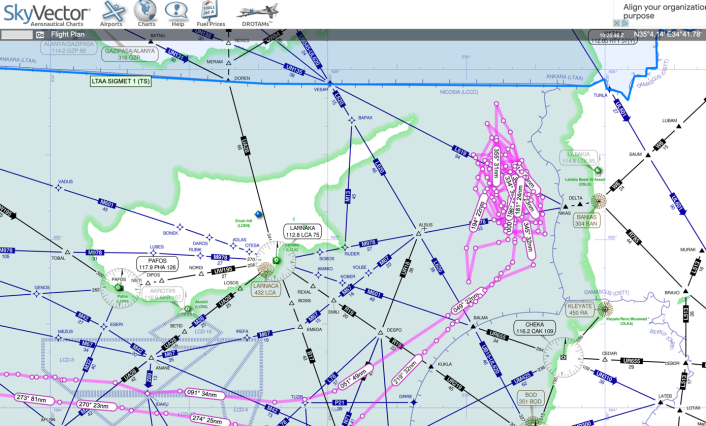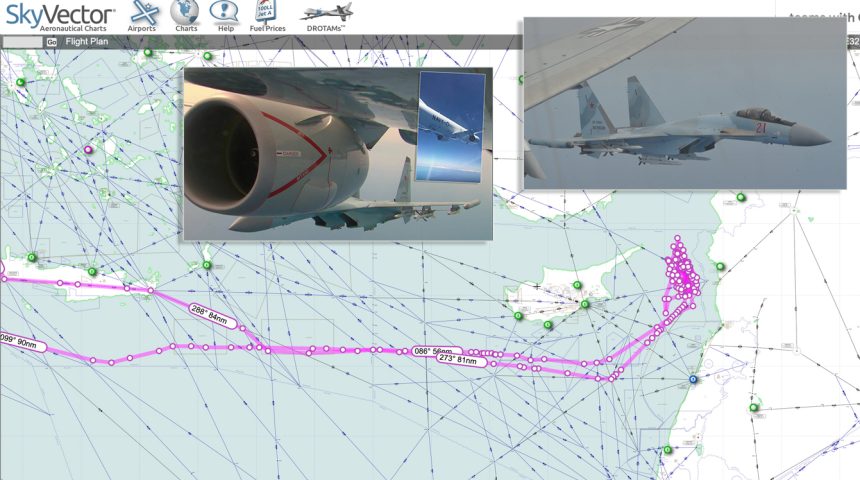We get a better idea of the area of operations of the P-8A that had a tense “close encounter” with two Su-35s.
As we have reported in detail in this previous article, a U.S. Navy P-8A Maritime Patrol and Reconnaissance Aircraft flying out of NAS Sigonella, Sicily, was intercepted by two Russian Su-35 Flanker derivative aircraft while operating over the eastern Mediterranean Sea on May 26, 2020. According to the U.S. 6th Fleet, that shared photos and videos, the Russian pilots “flew in an unsafe and unprofessional manner while intercepting the P-8.”
The surveillance aircraft was flying over international waters, when it was shadowed by the Russians.
This is what this Author wrote in the previous article commenting the few details released by the Navy: “the intercept lasted over 65 minutes, meaning that the American MPA (Maritime Patrol Aircraft) with ISR (Intelligence Surveillance and Reconnaissance) capabilities was probably flying close to the coast, most probably off Syria, where the P-8 is often tracked.”
Now, thanks to our friend Arjen Peters, we can have a better idea of the P-8 area of operations.

As the image shows, the Poseidon operated off Latakia, northwestern Syria, well outside the Syrian airspace but not too far from Hmeimim, the base that hosts the Russian Air Force contingent and, above all, the one where as many as 14 MiG-29s and Su-24s stopped over on their way to Libya.
In fact, as already reported, U.S. Africa Command assessed that Russian fighter jets were recently deployed to Libya in order to support Russian state-sponsored private military contractors (PMCs) operating on the ground in Libya. The Russian fighter aircraft were delivered after transiting Syria where they were repainted to camouflage their Russian origin.
Noteworthy, along with the satellite shot, AFRICOM also released a series of photographs and stills of Russian fighter jets, including MiG-29s, Su-34s and Su-35s, shot by spyplanes or drones’ EO/IR sensors or targeting pods (including one of a Su-35s possibly taken by a P-8 in another ISR mission off Syria).
AFRICOM later provided additional details about the deployment of the Russian jets to Libya, stating that “Over multiple days in May, Russian MiG 29s and SU-24 fighters departed Russia. At that time, all the aircraft have Russian Federation Air Force markings. After they land at Khmeimin Air Base in Syria, the MiG 29s are repainted and emerge with no national markings.”
So, it is possible that the “unsafe” intercept was carried out on the P-8 observing the residual movements of the Russian jets on delivery to Libya via Syria.
Interestingly, not only have the P-8s operated in that area. Earlier, between May 18 and 19, believed to be the window of transit of the first MiGs to Libya, Arjen has logged as many as 4x P-8A from Sigonella, Italy; 2x EP-3E ARIES from Souda Bay, Greece; 2x MQ-9 Reaper from Sigonella; and 2x U-2 from RAF Akrotiri, Cyprus, flew off Latakia, collecting imagery and data that was used to support AFRICOM claims.
18 MAY: USAF MQ-9 Reaper from Sigonella watching Mig-29’s at Khmeimim Air Base in Syria prior to their transit to Libya. Operating due regard at FL220 as JACKT17. @Aviation_Intel @AircraftSpotshttps://t.co/yRv3Id32dC pic.twitter.com/SYTBGp25Co
— Arjen Peters (@FireFlying11) May 26, 2020
Thanks! Some additional details in this thread (https://t.co/lxLLKyVgJk). Total score for the 18th and 19th (window of transit) is: 4x P-8A (LICZ), 2x EP-3E (LGSA), 2x MQ-9 Reaper (LICZ) and 2x U2 (LCRA). Flights either near Latakia or on the Med sea transition route.
— Arjen Peters (@FireFlying11) May 26, 2020









